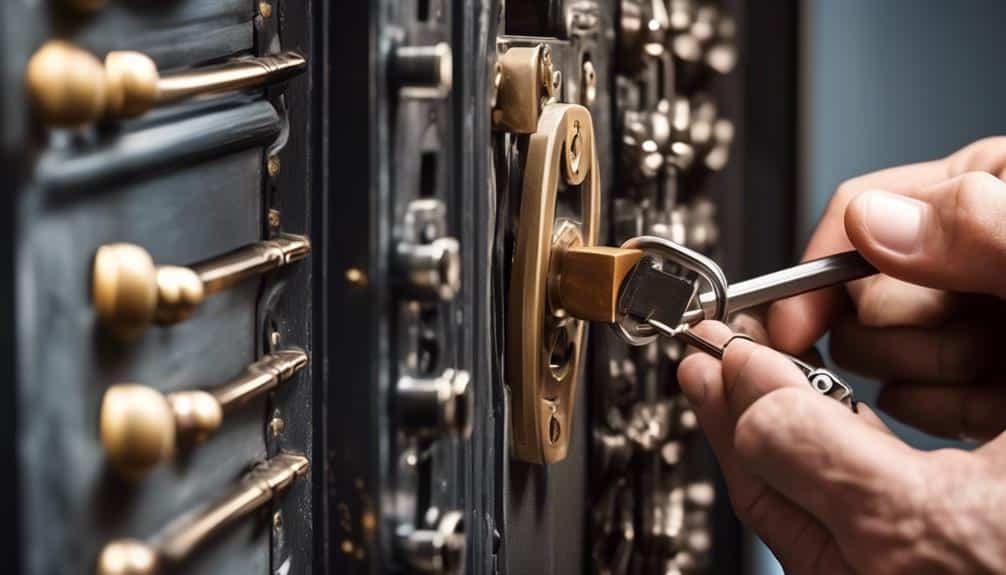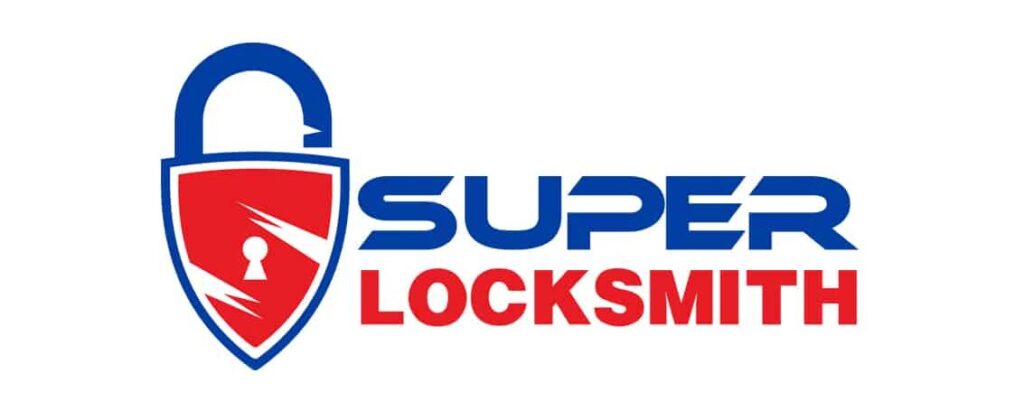Have you ever found yourself in a situation where you needed to duplicate a safe lock key? Perhaps you misplaced the original or needed an extra copy for a trusted individual. Whatever the reason may be, the process of copying safe lock keys requires expert knowledge and precision.
In this discussion, we will explore the intricacies of safe lock key duplication and provide you with valuable tips to ensure a successful outcome. From understanding different key types to choosing the right duplication service, we will cover everything you need to know.
So, let's delve into the world of safe lock key duplication and unlock the secrets behind this essential skill.
Importance of Safe Lock Key Duplication
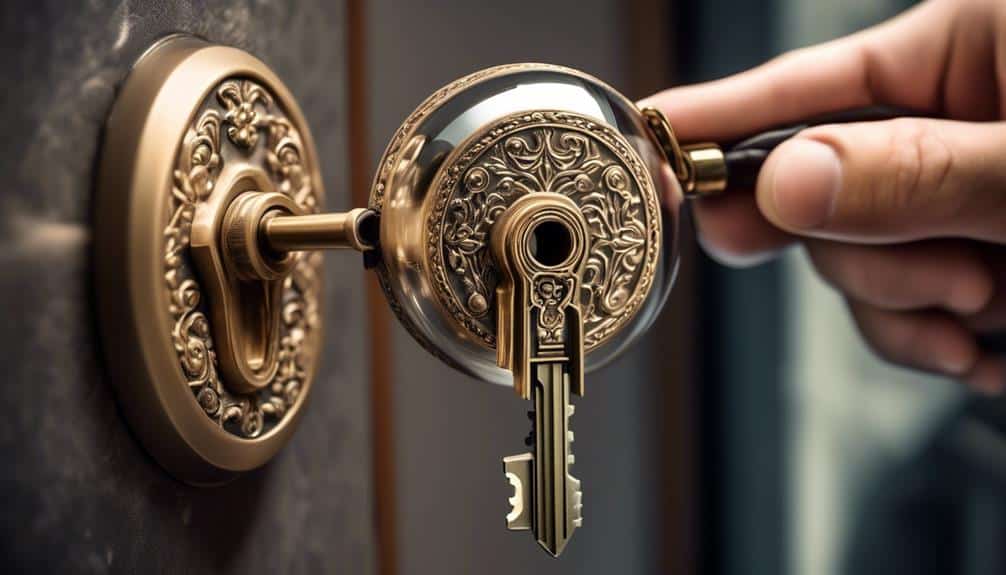
Safe lock key duplication is essential for ensuring the security and accessibility of valuable contents stored in a safe. When it comes to safeguarding valuable assets, it's crucial to have a reliable and durable key that can withstand daily use. Ensuring key durability is of utmost importance to prevent any unexpected failures or breakages that may compromise the security of the safe.
Duplication fraud is a serious concern in the realm of safe lock key duplication. Unauthorized access to safes can lead to theft, loss of confidential information, or even potential harm. By implementing secure key duplication practices, we can effectively prevent key duplication fraud. This involves strict control and verification processes, such as requiring proper identification and authorization from the safe owner before duplicating their keys.
Additionally, using advanced key cutting technologies and techniques can further enhance the security and prevent unauthorized duplication attempts.
Understanding Safe Lock Key Types
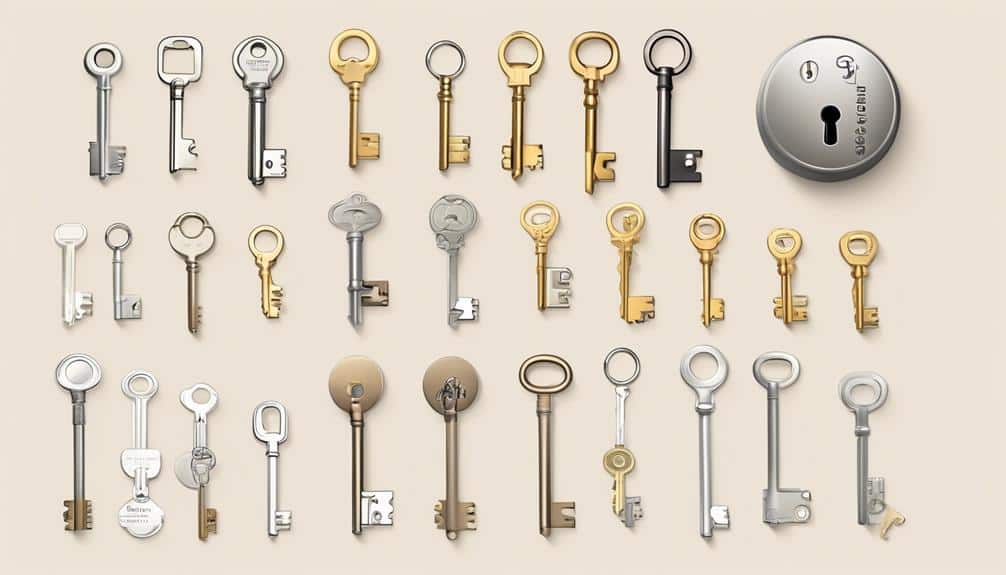
Different types of keys are used for safe locks to provide varying levels of security and access control. Understanding the classification of safe lock keys and the materials they're made of is crucial for locksmiths and security professionals.
Here are three key types commonly used in safe locks:
- Mechanical keys: These keys are the traditional type and are widely used in mechanical combination locks. They're typically made of durable materials such as brass or steel. Mechanical keys require physical manipulation to unlock the safe, providing a higher level of security.
- Electronic keys: With the advancement of technology, electronic keys have become popular for accessing safe locks. These keys use electronic components, such as RFID or magnetic strips, to communicate with the lock system. Electronic keys offer convenience and flexibility, allowing for multiple users and audit trails.
- Biometric keys: Biometric keys utilize unique physiological characteristics, such as fingerprints or iris patterns, for authentication. These keys provide a high level of security since they can't be easily duplicated or stolen. Biometric keys are commonly used in high-security applications where strict access control is required.
Identifying the Right Key Duplication Service
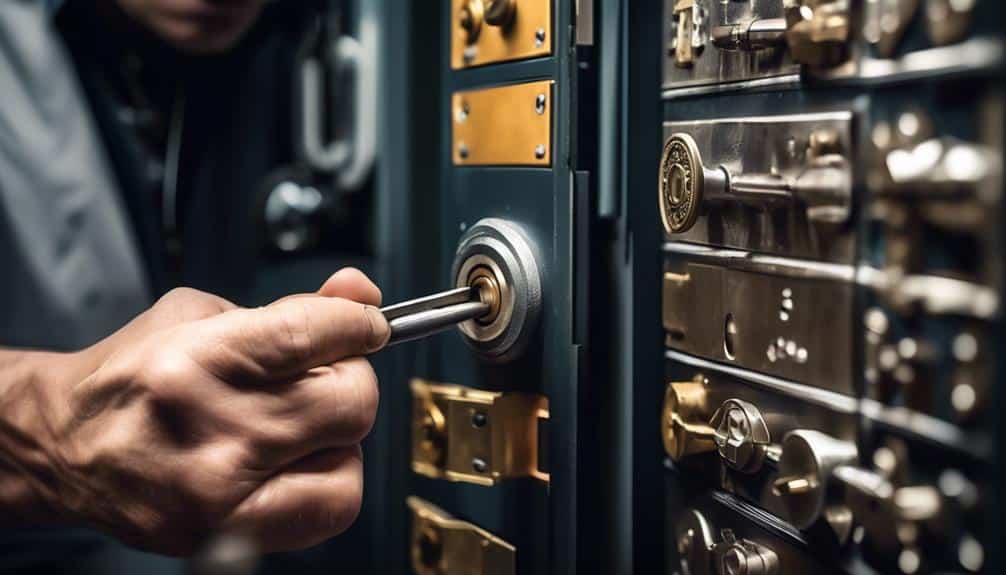
When it comes to identifying the right key duplication service for copying safe lock keys, there are a few key points to consider.
First, it's important to explore the various key duplication options available, such as traditional locksmiths or specialized key duplication services.
Second, quality assurance measures should be taken into account, such as ensuring the service provider uses high-quality materials and follows proper key duplication techniques.
Key Duplication Options
What are the key factors to consider when selecting the most suitable key duplication service?
When it comes to key duplication options, there are several important factors to keep in mind to ensure key accuracy. Here are three key considerations:
- Expertise and Experience: Look for a key duplication service that has a proven track record in the industry. Choose a provider that specializes in key duplication techniques and has experience working with various types of keys, including safe lock keys. This expertise will ensure that your duplicate keys are accurate and functional.
- Technology and Equipment: The right key duplication service should have advanced technology and high-quality equipment. This ensures precise duplication and minimizes the risk of errors. Look for a provider that invests in modern key cutting machines and software to deliver accurate results.
- Security and Trustworthiness: When duplicating safe lock keys, security is of utmost importance. Choose a key duplication service that values confidentiality and takes necessary precautions to protect your keys and personal information. Look for trusted providers that have a secure facility and follow strict security protocols.
Quality Assurance Measures
To ensure the accuracy and reliability of your duplicate keys, it's crucial to identify a key duplication service that implements quality assurance measures. When it comes to the importance of key security, choosing the right key duplication service becomes paramount. Implementing best practices for key duplication is essential in maintaining a secure and reliable lock system.
A reputable key duplication service will prioritize quality assurance measures to ensure that each duplicate key is an exact replica of the original. This involves using high-quality materials and precise cutting techniques to guarantee the accuracy of the duplicate key. Additionally, the service should have strict protocols in place to prevent unauthorized access to key duplication equipment and customer information.
Trustworthy Locksmith Selection
Finding a trustworthy locksmith is crucial when it comes to selecting the right key duplication service. To help you avoid locksmith scams and ensure you choose a reliable professional, here are some recommendations:
- Ask for recommendations from family, friends, or colleagues who've used locksmith services before. Personal referrals can provide valuable insights into the quality and trustworthiness of a locksmith.
- Check for proper licensing and certification. A trustworthy locksmith should have the necessary licenses and certifications to operate legally and demonstrate their expertise in the field.
- Read online reviews and ratings. Websites like Yelp or Google Reviews can offer insights into other customers' experiences with a particular locksmith, helping you make an informed decision.
Factors to Consider Before Copying Safe Lock Keys
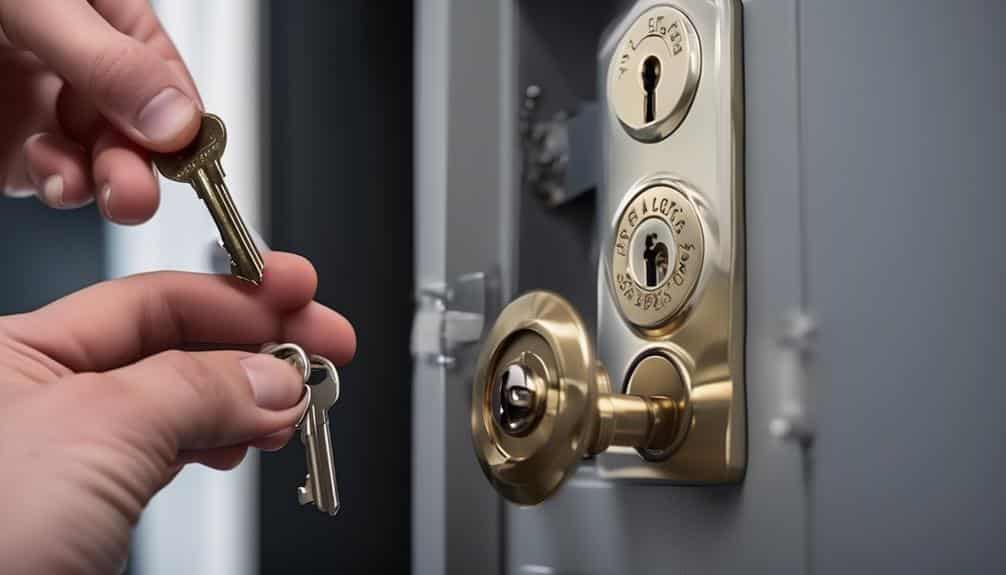
Before copying safe lock keys, it's important to carefully evaluate several key factors. These factors will help ensure the safekeeping of valuable possessions and protect against unauthorized access.
Firstly, consider the level of security provided by the existing lock system. Assess the strength and complexity of the lock to determine if it's suitable for duplicating keys. Additionally, check if the lock has any anti-picking or anti-bumping features that might affect the key duplication process.
Secondly, consider the purpose of duplicating the safe lock keys. Are you duplicating keys for backup purposes or to provide access to trusted individuals? Understanding the purpose will help determine the necessary level of security and the type of key duplication method to use.
Next, evaluate the reliability and trustworthiness of the locksmith or key duplication service provider. Ensure they have the necessary skills, experience, and reputation to handle safe lock key duplication. A reliable locksmith will ensure the accuracy of the duplication process and maintain the confidentiality of the keys.
Lastly, consider the benefits of duplicating safe lock keys. Key duplication provides convenience by allowing multiple trusted individuals to access the safe. It also serves as a backup in case of lost or misplaced keys.
Ensuring Security During Safe Key Duplication
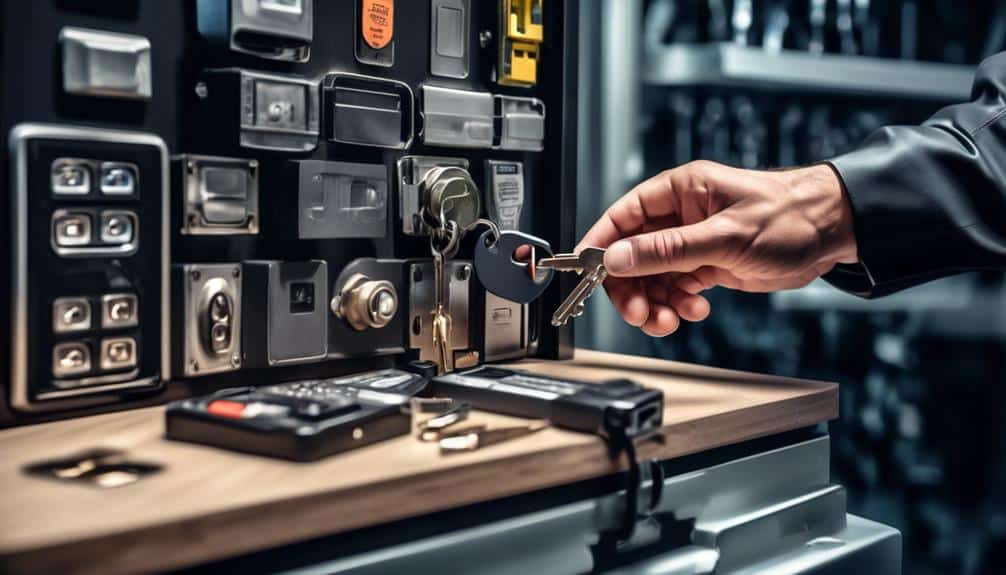
During safe key duplication, it's crucial to maintain strict security measures to safeguard the integrity of the process. To ensure security, we recommend implementing the following practices:
- Controlling Access: Limit the number of individuals who have access to the key duplication process. Only authorized personnel should be allowed to handle the keys and perform duplication.
- Maintaining Secure Key Storage: Store original keys in a secure location, such as a locked cabinet or safe. This will prevent unauthorized individuals from accessing the keys and potentially duplicating them without proper authorization.
- Preventing Unauthorized Key Duplication: Implement measures to prevent unauthorized key duplication. This can include using high-security key blanks and employing restricted key systems that require proper identification and authorization before key duplication is allowed.
Key Duplication Techniques for Safe Locks
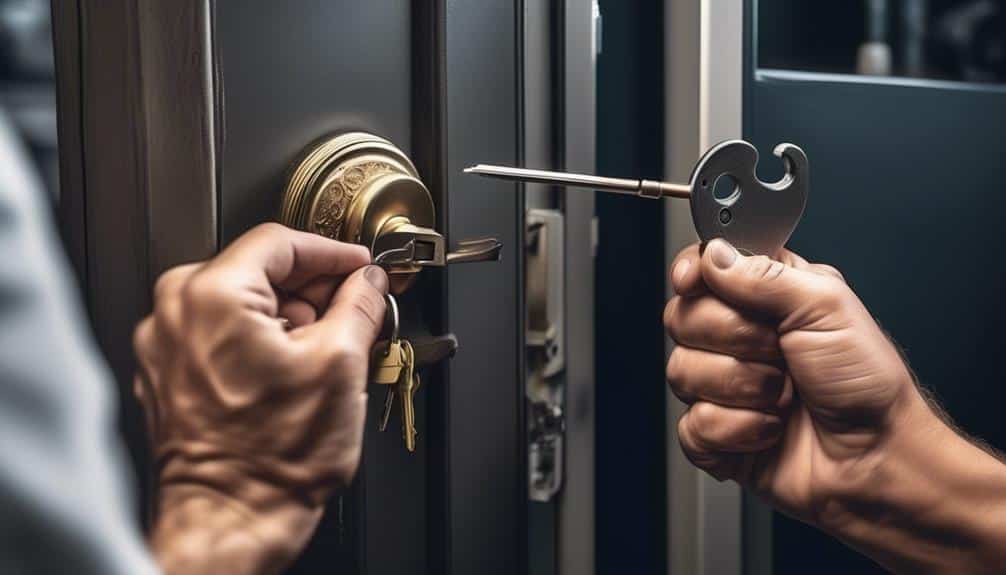
To ensure accurate and secure key duplication for safe locks, it is essential to employ precise techniques and adhere to strict security protocols. When it comes to safe lock key cutting, using the right tools is crucial. Key duplication tools specifically designed for safe locks ensure that the duplicate keys are cut accurately and fit securely into the lock.
To give you a better understanding, here is a table outlining some key duplication techniques for safe locks:
| Technique | Description | Advantages | Disadvantages |
|———–|————-|————|—————|
| Manual Key Cutting | Involves cutting the key by hand using a duplicating machine or grinder. | – Allows for precise customization.
- Can be done on-site. | – Requires skilled personnel.
- Time-consuming process. |
| Laser Key Cutting | Utilizes laser technology to cut the key with extreme precision. | – Provides highly accurate duplicates.
- Can cut complex key patterns. | – Expensive equipment.
- Limited availability. |
| Computerized Key Cutting | Uses computer-controlled machines to cut the key accurately based on digital specifications. | – Fast and efficient.
- Can store key patterns for future use. | – Costly initial setup.
- Requires technical expertise. |
Common Mistakes to Avoid in Safe Lock Key Duplication
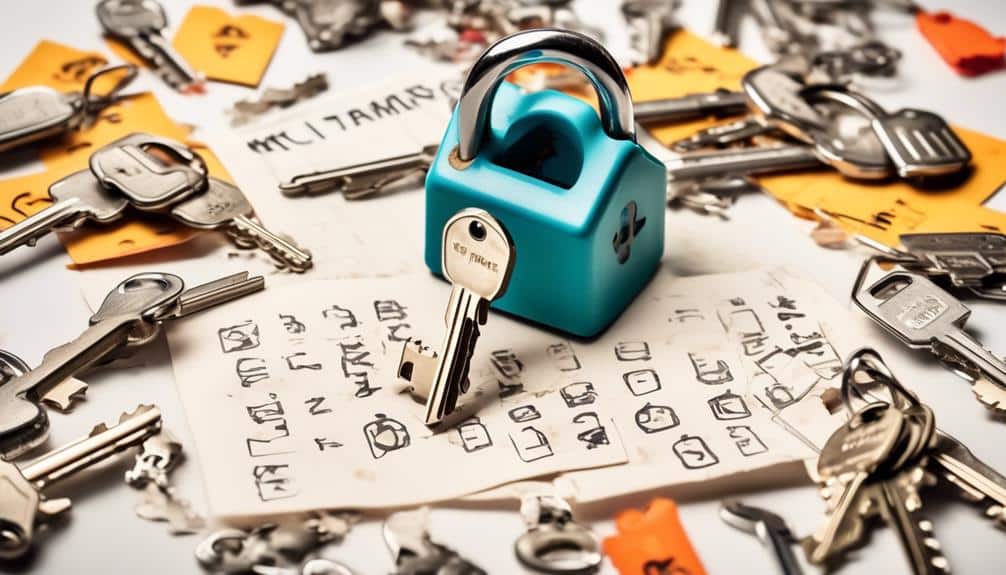
When it comes to duplicating safe lock keys, there are common mistakes that should be avoided. These errors can lead to key copies that don't function properly or compromise the security of the safe.
To ensure proper safe key copying, it's important to follow the correct procedures and use high-quality materials.
Key Duplication Errors
We must be cautious to avoid common mistakes when duplicating safe lock keys, as these errors can compromise the security and functionality of the key.
To ensure a successful duplication process, it's important to follow the necessary precautions. Here are some key duplication mistakes to avoid:
- Using low-quality key blanks: Opt for high-quality key blanks that are specifically designed for safe lock keys. Using substandard blanks may result in an inaccurate duplicate.
- Ignoring safe lock key security measures: Safe lock keys often incorporate advanced security features such as unique key codes or restricted keyways. Failing to account for these measures can lead to an ineffective duplicate that may not work in the lock.
- Not verifying the duplicate key's functionality: After duplicating the safe lock key, it's crucial to test its functionality. This involves ensuring that the duplicate key smoothly operates the lock without any resistance or difficulty.
Proper Safe Key Copying
Using high-quality key blanks specifically designed for safe lock keys is essential in ensuring an accurate and effective duplicate. However, proper safe key copying goes beyond just using the right key blank.
It also involves proper safe key storage and safe lock key maintenance. When duplicating safe lock keys, it's crucial to store them in a secure location, away from unauthorized access. This helps to prevent the keys from falling into the wrong hands and potentially compromising the safety of the contents within the safe.
Additionally, regular maintenance of the safe lock keys is necessary to ensure their optimal performance. This includes cleaning the keys regularly, checking for any signs of wear or damage, and promptly replacing any keys that show signs of deterioration.
Selecting the Right Key Duplication Equipment
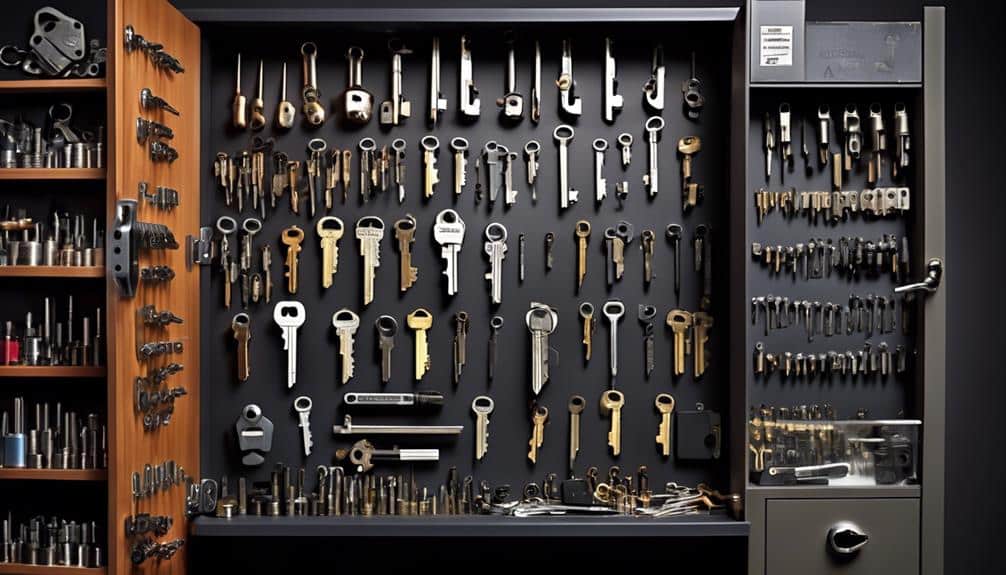
To ensure optimal key duplication, it's crucial to carefully select the appropriate equipment. When it comes to key duplication equipment selection, there are several factors to consider. Here are some expert tips to help you make the right choice:
- Reliability: Look for equipment that's known for its durability and reliability. This will ensure that the key duplication process is smooth and error-free.
- Versatility: Choose equipment that can handle a wide range of key types and sizes. This will allow you to offer a diverse key duplication service to your customers.
- Accuracy: Accuracy is paramount when it comes to key duplication. Look for equipment that's designed to provide precise and accurate duplicates every time.
Tips for Successful Safe Lock Key Duplication
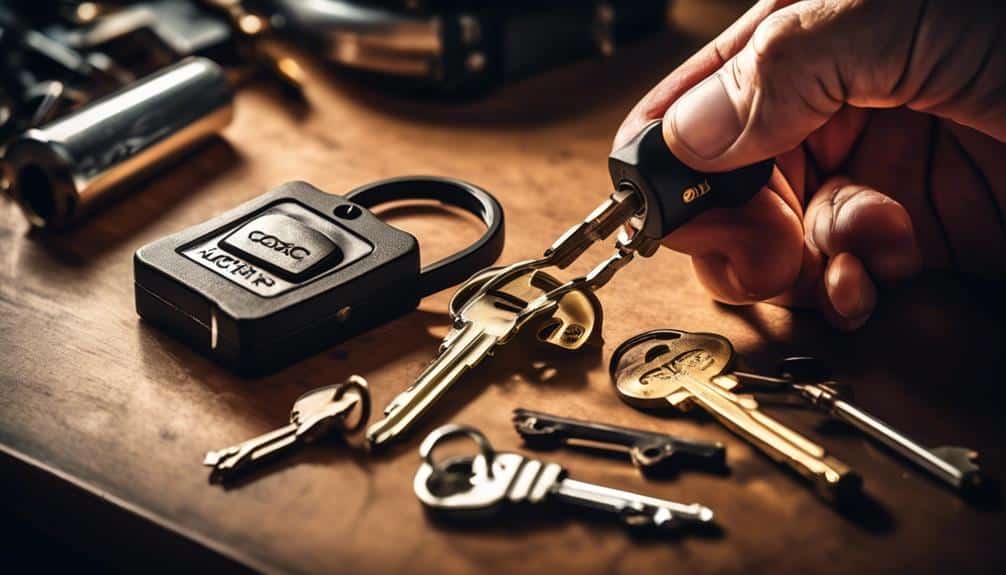
For successful safe lock key duplication, it's essential to follow these expert tips. When it comes to safe lock key duplication techniques, there are a few best practices that can ensure a successful outcome.
Firstly, it's crucial to carefully examine the original key before attempting duplication. Look for any unique features or markings that need to be replicated accurately. This step ensures that the duplicate key will function properly in the lock.
Next, select the appropriate key duplication equipment. Make sure it's specifically designed for safe lock keys and has the necessary precision and accuracy. Using substandard equipment can result in poorly cut keys that may not work correctly.
Before duplicating the key, it's advisable to clean the original key thoroughly. Any debris or dirt can affect the accuracy of the duplication process. A clean key ensures a more precise copy.
During the duplication process, ensure that the cutting machine is properly calibrated. This calibration ensures that the duplicate key is cut to the exact specifications of the original key.
Lastly, after duplication is complete, test the duplicate key in the lock to verify its functionality. If the key doesn't work smoothly or requires excessive force, it may need to be re-cut or adjusted.
Key Duplication Methods for Different Safe Brands
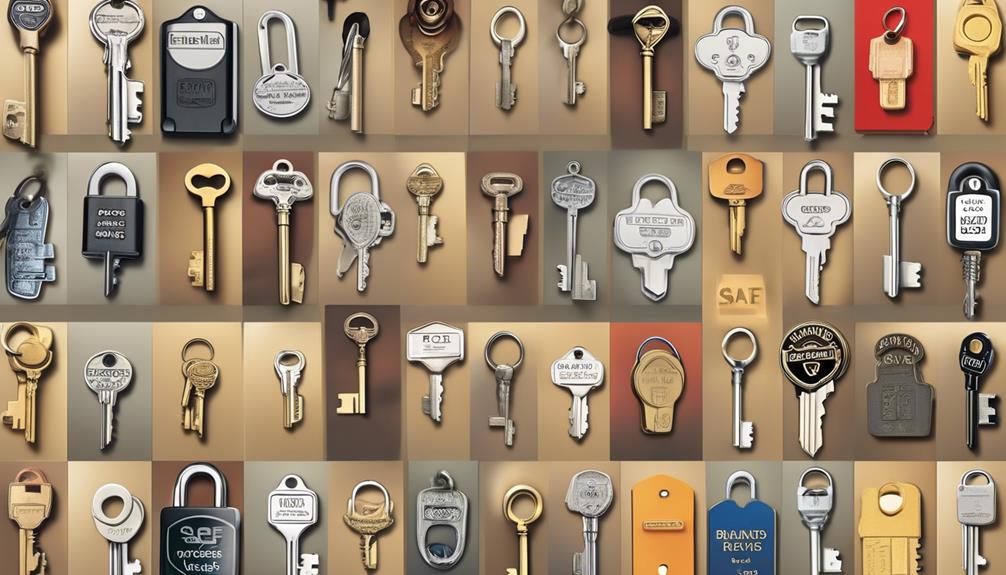
When it comes to key duplication for different safe brands, it's important to understand the popular safe key brands and the techniques used for duplication.
By knowing which brands are commonly used, we can determine the appropriate methods for duplicating their keys.
This knowledge allows us to provide accurate and effective key duplication services for our customers' specific safe brands.
Popular Safe Key Brands
We will now explore the key duplication methods for different popular safe key brands.
When it comes to duplicating keys for popular safe brands, there are several techniques that can be used. Here are three key duplication techniques for different safe brands:
- Brand A: For Brand A safes, the most effective method is the traditional key cutting technique. This involves using a key cutting machine to create an exact replica of the original key.
- Brand B: Brand B safes often require a more advanced technique known as impressioning. This involves creating a mold of the original key by carefully manipulating a blank key inside the lock until it matches the grooves and ridges.
- Brand C: Another popular safe key brand, Brand C, can be duplicated using the decoding method. This technique involves decoding the key's internal code and then using a specialized machine to cut a new key based on that code.
Techniques for Key Duplication
To explore the techniques for key duplication across different safe brands, we'll now examine the methods used for duplicating keys for popular safe key brands.
Key duplication techniques are crucial for locksmiths and individuals who need to duplicate safe lock keys. When it comes to safe lock key copying, it's important to understand that different safe brands may have unique key designs and security features. Therefore, the key duplication process can vary depending on the brand.
Some common key duplication techniques include impressioning, decoding, and key cutting. Impressioning involves creating a replica key by making an impression of the original key in soft material.
Decoding, on the other hand, involves analyzing the key's internal components to decode its bitting code.
Key cutting is a widely used technique that involves duplicating a key by cutting a new key based on the original key's specifications.
Understanding these key duplication techniques allows locksmiths and individuals to effectively duplicate safe lock keys across different brands.
Maintaining the Integrity of Safe Lock Keys
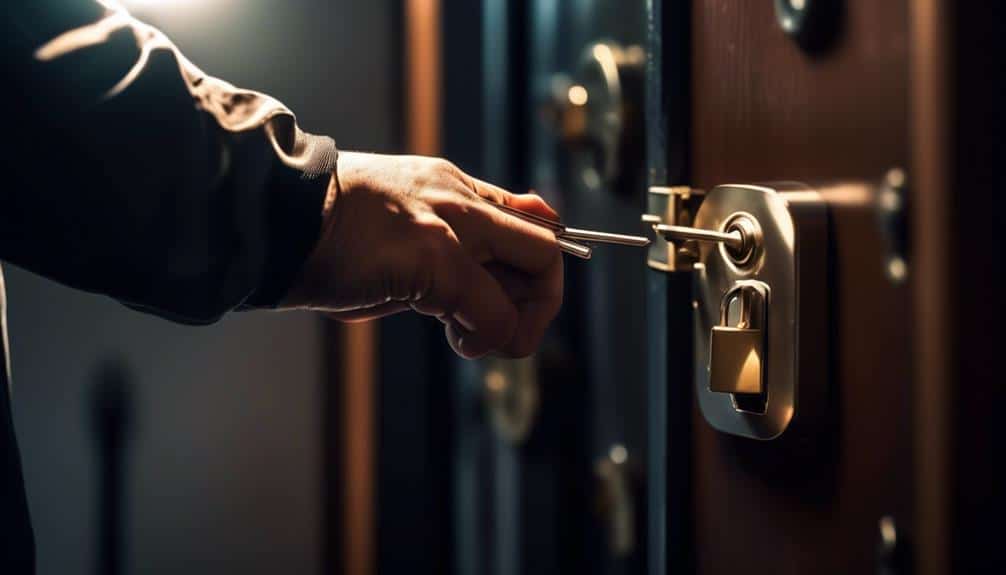
Maintaining the integrity of safe lock keys is crucial for ensuring the security and reliability of the locking system. To effectively maintain key durability and prevent key duplication fraud, consider the following:
- Regular Maintenance:
- Keep keys clean and free from debris to avoid potential damage to the key's structure.
- Lubricate the key periodically to minimize friction and ensure smooth operation.
- Inspect keys for any signs of wear or damage, and replace them if necessary.
- Controlled Key Access:
- Implement strict key control policies to prevent unauthorized access to key duplication equipment.
- Limit the number of individuals authorized to duplicate keys and maintain a log of all key duplications.
- Store keys securely in a designated area, accessible only to authorized personnel.
- Key Duplication Techniques:
- Utilize high-security key duplication methods, such as laser cutting or dimple key duplication, to enhance key security and make duplication more difficult.
- Consider using restricted key systems that require specialized equipment and authorization to duplicate keys.
Troubleshooting Key Duplication Issues
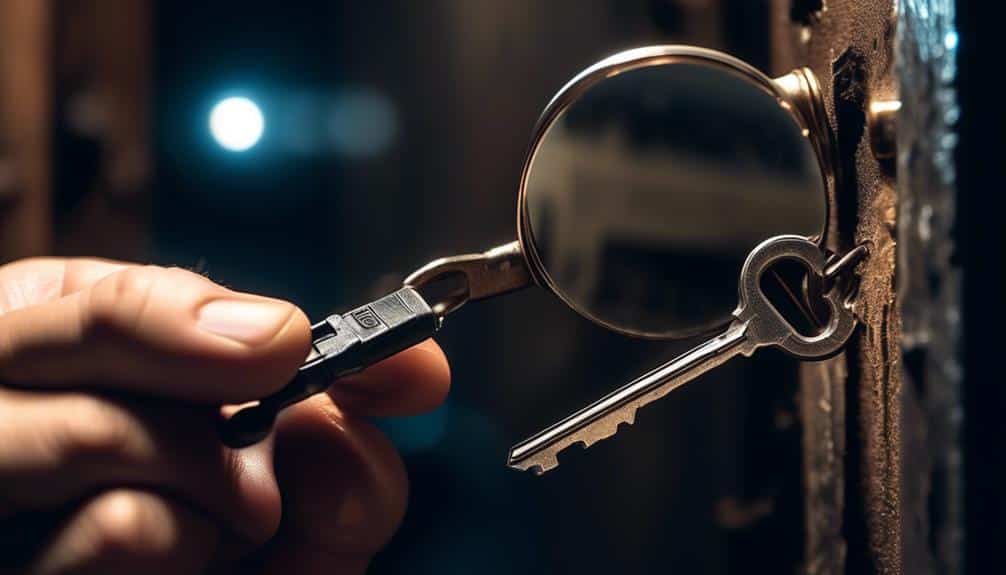
After ensuring the integrity of safe lock keys through regular maintenance and controlled key access, troubleshooting key duplication issues is an essential step in maintaining the security of the locking system.
Common key duplication mistakes can compromise the security of high security safe locks, making it crucial to address any issues promptly.
One common mistake is using low-quality key blanks for duplication. These blanks may not have the necessary precision or durability to create an accurate duplicate. To avoid this, it's important to use high-quality key blanks that are specifically designed for the type of safe lock being duplicated.
Another mistake isn't properly calibrating the key cutting machine. This can result in inaccuracies during the duplication process, leading to keys that don't function properly. Regular maintenance and calibration of key cutting machines can help prevent this issue.
In addition to avoiding common mistakes, there are specific key duplication techniques for high security safe locks that should be followed. These techniques may involve using specialized equipment or following specific procedures to ensure an accurate duplication.
Safe Lock Key Duplication Best Practices
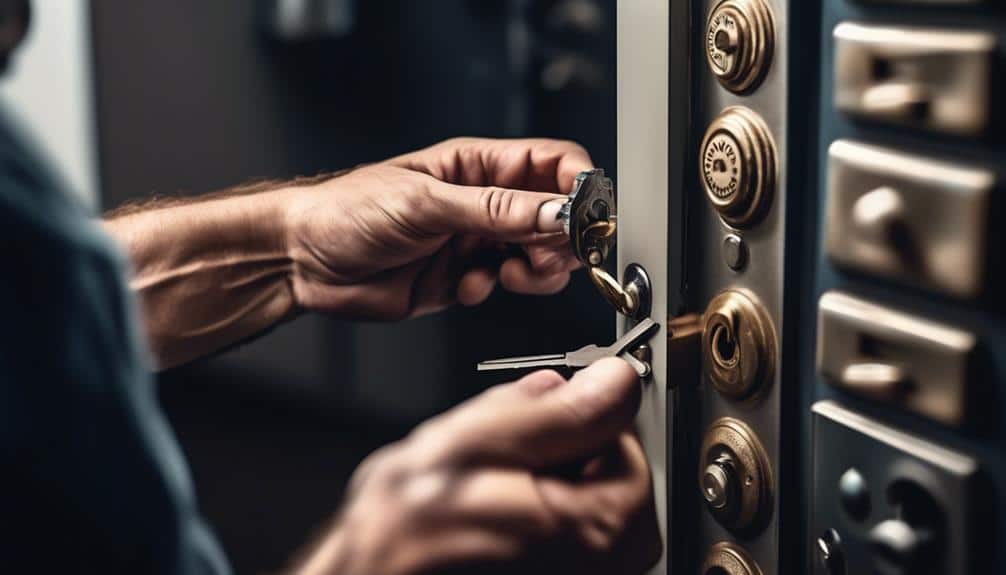
When it comes to safe lock key duplication, there are a few essential practices to keep in mind.
First and foremost, it's important to ensure the security of the keys being duplicated. This means following strict protocols and verifying the identity and authorization of the individual requesting the duplication.
Key Duplication Essentials
To ensure the utmost security, it's essential to adhere to best practices when duplicating safe lock keys. When it comes to key duplication, accuracy is paramount in order to avoid duplication mistakes. Here are three key duplication essentials that can help ensure the accuracy of your duplicated safe lock keys:
- Choose a reputable locksmith or key duplication service that specializes in safe lock keys. Their expertise and experience in handling safe lock keys will minimize the risk of errors.
- Provide the original key to the locksmith or service provider. This ensures that the duplicated key is an exact replica of the original, reducing the chances of any discrepancies.
- Verify the duplicated key's functionality by testing it on the safe lock before finalizing the duplication process. This step allows you to catch any potential issues or inaccuracies before relying on the duplicated key for security.
Safe Lock Key Security
For optimal security, it's crucial to implement safe lock key duplication best practices. Safe lock key maintenance is essential to ensure the continued effectiveness of the key and the lock system.
Regularly inspect the key for signs of wear or damage, such as bent or worn-down teeth. If any issues are detected, promptly replace the key to prevent potential security breaches.
When replacing a safe lock key, it's vital to follow the manufacturer's guidelines and use authorized key duplication services. Avoid using unauthorized vendors or online services, as they may not adhere to the necessary security protocols.
Expert Advice for Safe Lock Key Duplication
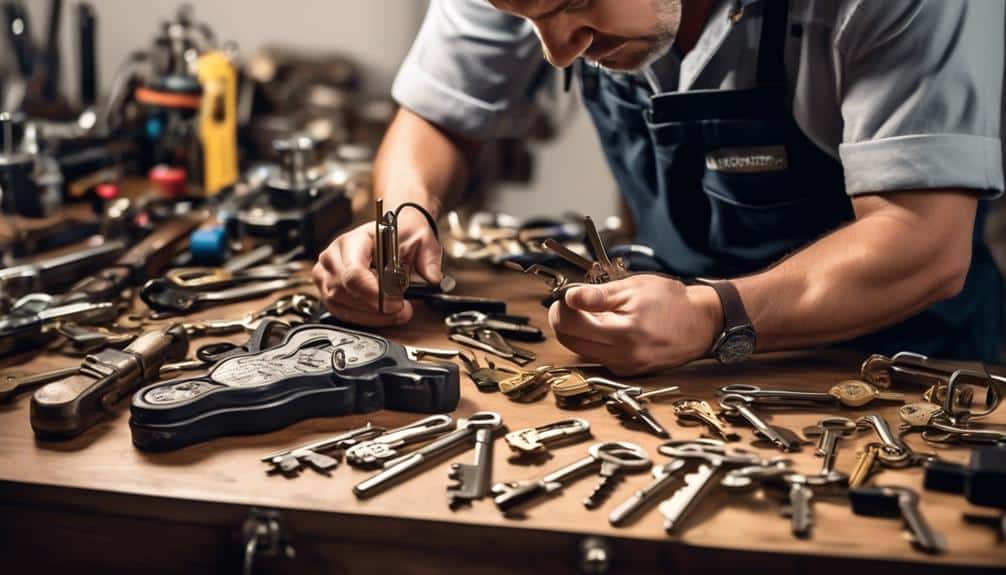
We recommend seeking professional guidance for duplicating keys for safe locks to ensure accuracy and security.
When it comes to safe lock key duplication, understanding the key duplication process and ensuring key duplication accuracy is crucial. Here are some expert tips to help you navigate this process:
- Choose a reputable locksmith: Look for a locksmith with experience in safe locks and a good reputation for accuracy and security.
- Provide detailed information: When seeking key duplication, provide the locksmith with all the necessary details about the safe lock, including the brand, model, and any specific features.
- Use high-quality blank keys: Ensure that the locksmith uses high-quality blank keys that match the specifications of your safe lock.
Frequently Asked Questions
Can I Duplicate a Safe Lock Key Myself at Home?
We've all wondered if it's possible to duplicate a safe lock key at home. While it may seem tempting to try, there are important factors to consider.
Home duplication techniques for safe lock keys exist, but they come with their own set of pros and cons. It's crucial to weigh the risks and benefits before attempting DIY duplication.
Let's explore the technicalities, advantages, and drawbacks of duplicating safe lock keys yourself.
Are There Any Legal Restrictions on Duplicating Safe Lock Keys?
There may be legal consequences for unauthorized duplication of safe lock keys.
It's important to understand that duplicating safe lock keys without proper authorization can lead to serious penalties.
The consequences of unauthorized duplication may include legal action, fines, and even imprisonment.
It's crucial to respect the laws and regulations surrounding safe lock keys and seek professional assistance when needed.
How Long Does It Typically Take to Duplicate a Safe Lock Key?
When it comes to duplicating a safe lock key, the time it typically takes can vary. Factors such as the complexity of the lock and the expertise of the locksmith can play a role.
To ensure a smooth and efficient process, it's crucial to choose a reliable locksmith with experience in duplicating safe lock keys.
Common mistakes to avoid include using unqualified locksmiths or attempting the duplication yourself without proper knowledge and tools.
Can I Duplicate a Safe Lock Key if I Don't Have the Original Key?
Yes, we can duplicate a safe lock key even if we don't have the original key. There are alternative methods available to copy a safe lock key, such as impressioning or decoding the lock.
These methods require technical expertise and specialized tools. Impressioning involves making an impression of the lock using a blank key, while decoding involves analyzing the lock's internal mechanism to create a duplicate key.
It's recommended to consult a professional locksmith for accurate and reliable results.
What Should I Do if the Duplicated Safe Lock Key Doesn't Work?
If the duplicated safe lock key doesn't work, there could be a few reasons why.
One possibility is that the key wasn't accurately replicated, which can happen if the copying process wasn't done properly.
Another reason could be that the lock itself is faulty or damaged.
To troubleshoot this issue, it's recommended to double-check the accuracy of the key duplication and consider seeking professional assistance if needed.

